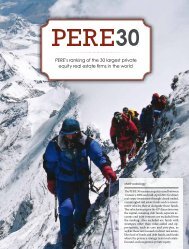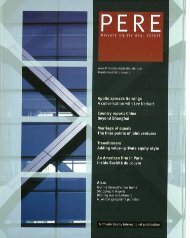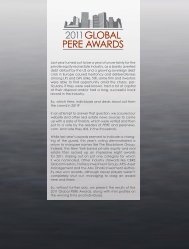2010AWARDS & AnnuAL REVIEW - PERE
2010AWARDS & AnnuAL REVIEW - PERE
2010AWARDS & AnnuAL REVIEW - PERE
Create successful ePaper yourself
Turn your PDF publications into a flip-book with our unique Google optimized e-Paper software.
AnnuAl review | AsiAview<br />
Changing of the guard<br />
As investment banks backed out of Asia’s private equity real estate sector, <strong>PERE</strong><br />
considers those primed to take their place. By Jonathan Brasse<br />
In Asia, 2010 will be remembered as the<br />
year that Wall Street’s presence diminished<br />
in the region. The departures of<br />
Bank of America Merrill Lynch (BoA<br />
ML), Citi Property Investors (CPI) and<br />
insurance giant American International<br />
Group from the sector were one sign<br />
of that.<br />
A look at Real Capital Analytics’ 2010<br />
figures for the region highlighted another.<br />
According to the research group,<br />
Wall Street rivals Goldman Sachs and Morgan Stanley were<br />
net sellers in the region to the tune of $1.9 billion and $1 billion,<br />
respectively – the fourth and ninth biggest net sellers<br />
last year.<br />
Indeed, while Morgan Stanley Real Estate Investing (MS-<br />
REI) finally achieved a $4.7 billion closing for its seventh<br />
global real estate fund in May, <strong>PERE</strong> learned in December<br />
that what the firm is willing to buy in the region had been<br />
tempered somewhat. Responding to questions after it closed<br />
Morgan Stanley Capital Korea, the firm revealed that its Asia<br />
investing strategy had been restricted to value-added and<br />
distressed plays in developed markets and growth plays in<br />
emerging markets. That no longer included Korea, it noted.<br />
Perhaps it is strategy evolution, but Morgan Stanley pulled<br />
the curtain down on a 10-year tenure in<br />
the country as a consequence of the shift.<br />
The market will be fascinated to follow the<br />
activities of MSREI’s head of Asia Hoke<br />
Slaughter, its chief executive officer for Japan<br />
Yoshihiko Shigenari and the rest of the<br />
team over the coming year to see if its efforts<br />
are truly redeployed elsewhere.<br />
Meanwhile, at Goldman Sachs, its last<br />
fund was the $2.1 billion Whitehall Street International Real<br />
Estate 2008, and there have been no reports of a follow-up<br />
fund to date. Furthermore, the almost $2 billion of disposed<br />
assets in Asia last year accounted for two-thirds of all its disposals<br />
globally, further demonstrating it hasn’t prioritised the<br />
region ahead of others. For more context, look again to RCA,<br />
which noted that Goldman purchased just two assets in Asia<br />
throughout the whole of the year – a 46,000-square-foot office<br />
in May and a Labi 1 electronics store three months earlier,<br />
both in Japan.<br />
Bank of America Merrill Lynch’s departure from principal<br />
investing in Asia was possibly <strong>PERE</strong>’s most coveted story of<br />
2010. No quiet backtracks there, rather a complete exit for the<br />
firm. After quelling litigation threats for actions considered<br />
non-fiduciary by the LPs of its Asian Real Estate Opportuni-<br />
52 <strong>PERE</strong> | 2010 AwArds & AnnuAl review<br />
2010 will be<br />
remembered as the<br />
year that Wall Street’s<br />
presence diminished<br />
in the region<br />
ties Fund via a handsome $650 million settlement, the $2.65<br />
billion fund and its other Asia balance sheet assets now sit<br />
with The Blackstone Group.<br />
That brings us to the players for 2011.<br />
Blackstone had a presence in Asia a couple of years before<br />
assuming control of the 50-person BoA ML platform,<br />
but its offices in Hong Kong, Tokyo and Mumbai had been<br />
pretty quiet until then. The transaction sees it inherit approximately<br />
$8 billion of assets to work through and approximately<br />
25 more limited partners with which to work<br />
on future investment products. Expect to hear more about<br />
platform leaders Chris Heady, Alan Miyasaki and Tuhin<br />
Parikh going forward.<br />
Likewise, Blackstone’s private equity rival Apollo Global<br />
Management. Before picking up Citi Property Investors, Leon<br />
Black’s firm – the real estate activities of which are led by industry<br />
veteran Joseph Azrack – picked up the smaller Holdfast<br />
Capital. Through Holdfast, Apollo acquired the nucleus<br />
of a platform led by Colony Capital’s former Asia head Grant<br />
Kelley as well as a fund in incubation. The adopted fund, originally<br />
focused on Asia’s mature economies including Australia,<br />
Japan and Korea, is expected to hold a closing this year.<br />
On a smaller scale, a host of companies chose 2010 as the<br />
year to graduate from investing on a deal-by-deal basis to trying<br />
their hand at blind pool, commingled vehicles. Examples<br />
included Hong Kong and Singapore investor<br />
Pamfleet Group and Sydney-based LIDIS.<br />
Such activity surely stems from increasing<br />
positive sentiment from investors towards<br />
Asia. According to <strong>PERE</strong>’s Capital<br />
Watch figures, more than $5 billion was<br />
raised for Asia-specific value-added and opportunity<br />
funds. That was paltry compared<br />
to the $18.97 billion raised in 2008, but up<br />
from 2009 levels. And while most of the world’s largest LPs<br />
are seeking alternatives to traditional commingled funds,<br />
that is not true for all of them.<br />
Look at the National Pension Service of Korea, for example.<br />
It has $1.2 billion of commitments earmarked for higher risk<br />
funds in early 2011, a significant portion of which will go to<br />
Asia. Additionally, there is a world of smaller investors that<br />
have remained faithful to such vehicles.<br />
It could have been the Volcker rule, which will limit principal<br />
investing by US banks, that prompted a changing of the<br />
guard in Asia. More likely, however, it was the dire fortunes<br />
of their 2006, 2007 and 2008 vintage funds that sealed the<br />
demise of those efforts. Regardless, <strong>PERE</strong> has a new breed to<br />
write about, ensuring that 2011 stands to be a most interesting<br />
year.







